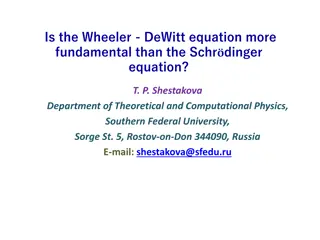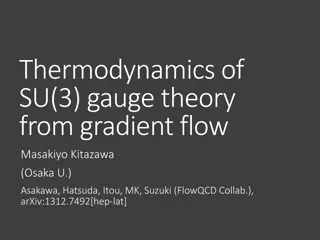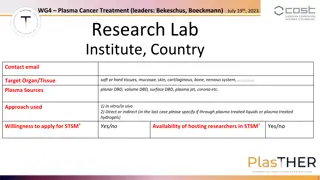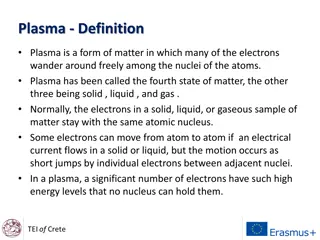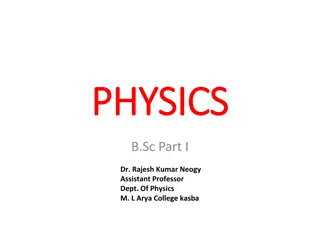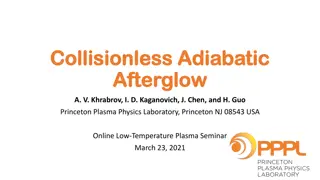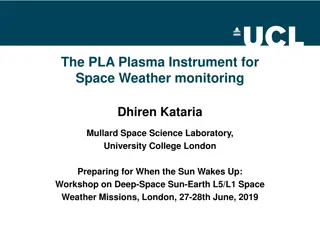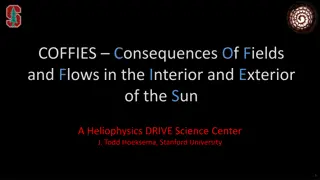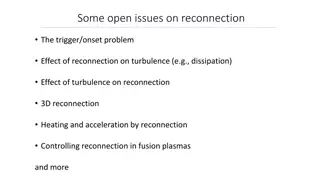Thermodynamics of Solar Plasma: SAHA-S Equation of State and Recent Results
SAHA-S equation of state (EOS) presents the current state and recent results in thermodynamics of solar plasma. Key authors V.K. Gryaznov, A.N. Starostin, and others have contributed to this field over 20 years. The equilibrium composition between 145 species, including elements and all ions, is explored with detailed partition functions and Coulomb interaction modeling. Methodical remarks highlight the challenges and limits of comparing physical and chemical pictures in plasma systems.
Download Presentation

Please find below an Image/Link to download the presentation.
The content on the website is provided AS IS for your information and personal use only. It may not be sold, licensed, or shared on other websites without obtaining consent from the author. Download presentation by click this link. If you encounter any issues during the download, it is possible that the publisher has removed the file from their server.
E N D
Presentation Transcript
SAHA-S Equation of State Present state and recent results V.A.Baturin*, A.V.Oreshina, S.V.Ayukov, V.K.Gryaznov Sternberg Astronomical Institute, Lomonosov Moscow State University
SAHA-S EOS (20 years story) Authors: V.K.Gryaznov, Institute of Problems of Chemical Physics RAS, Chernogolovka, Russia; I.L.Iosilievskiy, Moscow Institute of Physics and Technology, Dolgoprudnyi, Russia; A.N.Starostin, Troitsk Institute for Innovation and Fusion Research, Troitsk, Russia; V.E.Fortov, Institute of Problems of Chemical Physics RAS, Chernogolovka, Russia; References: V.K.Gryaznov et al., J. Phys. A: Math. Gen. 39 (2006) p. 4459 1. S.V.Ayukov et al., JETP Letters, Vol. 80, No. 3, (2004) p. 141 2. V.K.Gryaznov et al. in Equation-of-State and Phase-Transition Issues in Models of Ordinary Astrophysical Matter , Eds. V.Celebonovic, W.Dappen, D.Gough, AIP Conference Proceedings v. 731, (2004) p.147, and several papers ibid. Availability of basic tables: 3. Basic tables of SAHA-S EOS are available via http://crydee.sai.msu.ru/SAHA-S_EOS
Thermodynamics of solar plasma SAHA-S e A+ A+ Equilibrium composition between 145 species: {e, H, H+, ..., He, He+, He+2, C, C+, , N, N+, , O, O+, ,Ne, Ne+, }, Elements (H He C N O Ne Si Fe Mg S) and all ions and selected molecules A++ A A+ + e A Ze rc A++ Partition functions: Modification of Planck-Larkin partition function (A.Starostin, 2002-2004 [1]) Coulomb interaction: Debye approximation in Grand canonical ensemble Ry 3 D cc P = = 3 ei 2 T n F ( ) exp = ; e e i n 2 n T 3 24 k T f n 1 B = + 2 i ln 1 ; i Z D = F ( ) 1 2 k T n B 6 4 ( ) ( ) 2 i Z n L / 1 2 / 3 2 + + E e 4 E E n = 2 D 3 4 i f n n = + 2 i 1 i 1 Z D / 1 ( , 2 E ) ( ) 2 2 + + 3 4 E 4 E n n n
Effect of excited states of atom modelled with the partition function. Planck-Larkin Starostin-Roerich 1/2 3/2 6 4 E = + + SR 1 4 E e E E ( ) 1 n = E E n n n PL E e E e n n n n 1, 2 E n 2 + 3 4 + 4 . E E n n
Methodical remarks (1) Using the PL-partition function in physical picture has a specific context and appeared in the term, which proportional to the product of activities of proton and electron. And in a general case, it is not possible to compare directly this term to one in chemical picture. As result, using PL and the other type of partition functions as effective statistical weights in chemical picture is not well justified. (2) There are two limits where physical and chemical picture may be equivalently compared. First one is plasma without the Coulomb interaction between free classical charges. The second limit is the fully ionized plasma. Both cases look not very appropriate for a real system, but they may be found at solar conditions in some approximation. (3) Strictly speaking, the partition function was obtained for hydrogen only. There are reasons to extend this result to hydrogen-like ion. But even for helium atom, theoretical basis for usage of such function is rather weak.
Current conclusions. - SR-function is always larger than PL-function. In the region where lgT=5, the SR predicts 20% excess of the statistical weight due to the contribution of excited states in compare to the case of ground state only. - Ionization equilibrium in SR case is shifted towards neutrals and the same degree of ionization is moved to higher temperature. - The SR-partition function model applies to all composite particles. On the figure the Q-profile for He+ are shown. Our general suggestion is that the partition function should be the same for hydrogen-like ions.
Current conclusions. - Ionization is shifted towards higher temperature in SR-case in comparison with PL-case. It is a systematic effect with the same sign at all temperatures. - This ionization shift is most prominent when ionization degree exceeds 1/2. - The region of the most correction to hydrogen ionization matches to the helium ionization hump.
Current conclusions. - 1- profile for pure hydrogen in the PL-case appears to be shifted toward higher temperature at the lgT=5.0 - Amplitude of the difference is as large as 1e-2. - The same effect of 1-disturbance appears for all H-like ionizations.
Conclusions. - The positions of the helium hump in the models with different partition functions demonstrate the remarkable shift towards higher temperature in the PL-case. The shape of the He-hump is similar in both cases. - It does not mean that helium ionization takes place lately in PL- case. Instead, the ionization degree curves show an inverse shift. The shift is explained by the similar effective shift of the pure hydrogen 1-profile. - The 1-disturbance due to excited states contributions can hardly be ignored in the helioseismic inversion. The shift of such amplitude may lead to change of helium content measurement by 5%! - Combinatorial interference of H-He effect gives us a chance to study the role of excited states in the solar plasma.
II. Coulomb correction in SAHA-S in comparison with classic DH-correction.
General conclusions: A. Effect of excited states could disturb 1 in pure hydrogen by 1e-2. It has magnified effect on position of He-hump. B. Coulomb correction in GCE model decrease 1 by 3e-4 in comparison with classic DH correction. This decrease brings it close to OPAL calculation with 1e-4 accuracy. All estimations are made at maximum of 1. C. Accuracy of theoretical 1 in the deep adiabatic part is better than 5e-5.
Thank you for your attention!!! Object for meditation and contemplation












